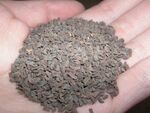Peganum harmala
| Peganum harmala | |
|---|---|
 P. harmala in the nature. |
|
| Taxonomical nomenclature | |
| Kingdom | Plantae |
| Unranked | Angiosperms |
| Unranked | Eudicots |
| Unranked | Rosids |
| Order | Sapindales |
| Family | Nitrariaceae |
| Genus | Peganum |
| Species | P. harmala |
| Common nomenclature | |
| Common names | Espand, Esfand, Syrian rue |
| Constituents | |
| Active constituents | Harmala alkaloid |
Peganum harmala, commonly called Syrian rue, harmel, espand, esfand, wild rue, African rue, or aspand, is a plant native to the eastern Iranian region west to India. It has also spread invasively throughout Arizona, California, Montana, Nevada, Oregon, Texas and Washington.[1] The plant itself produces seeds which contain harmala alkaloids and is easily accessible and legal to purchase online.
Chemistry

Powdered syrian rue seeds act as a MAOI at doses of 2-5g. Syrian rue seeds contain several different harmala alkaloids at slightly varying percentages. Only some are monoamine oxidase A inhibitors. In one study, total harmala alkaloids were at least 5.9% of dried weight.[2][3][4] Seed extracts were potent reversible and competitive inhibitors of MAO-A but poor inhibitors of MAO-B.[5]
Total harmala alkaloids were at least 5.9% of dried weight, in one study.[4]
| Alkaloid | Content | Type |
|---|---|---|
| Desoxypeganine[6] | MAO-A[7] | |
| Harmalicidine[8] | ||
| Harmaline (harmidine) | 0.25%[4]–0.79%[9]–5.6%[5] | Reversible inhibitor of monoamine oxidase A (RIMA) |
| Harmalol | 0.6%[5]–3.90%[4] | |
| Harmane (harman) | 0.16%[4] | MAO-A and MAO B[10] |
| Harmine (banisterine, telepathine) | 0.44%[9]–1.84%[4]–4.3%[5] – The coatings of the seeds are said to contain large amounts of harmine.[11] | Reversible inhibitor of monoamine oxidase A (RIMA) |
| Tetrahydroharmine (THH) | 0.1%[5] | Serotonine reuptake inhibitor[12] |
| Vasicine (peganine)[13] | 0.25%[9] | |
| Vasicinone[13] | 0.0007%[9] |
Toxicity and harm potential
Dangerous interactions

See the MAOI page for substances that may cause dangerous interaction.
Cholinergics
Cholinergic substances combined with Peganum harmala can cause a cholinergic crisis because the plant contains several acetylcholinesterase inhibitors (AChEIs):
Drug use in pregnancy
Peganum harmala can induce miscarriage. It has traditionally been used as an abortifacient agent in Morocco, North Africa, and the Middle East.[17] It is believed that quinazoline alkaloids such as vasicine and vasicinone are responsible for the abortifacient activity of the plant.[18]
See also
External links
References
- ↑ https://plants.usda.gov/core/profile?symbol=PEHA
- ↑ http://www.phcogrev.com/article.asp?issn=0973-7847;year=2013;volume=7;issue=14;spage=199;epage=212;aulast=Moloudizargari
- ↑ http://www.tandfonline.com/doi/abs/10.1080/15563650701323205
- ↑ 4.0 4.1 4.2 4.3 4.4 4.5 Hemmateenejad B, Abbaspour A, Maghami H, Miri R, Panjehshahin MR (August 2006). "Partial least squares-based multivariate spectral calibration method for simultaneous determination of beta-carboline derivatives in Peganum harmala seed extracts". Anal. Chim. Acta. 575 (2): 290–9. doi:10.1016/j.aca.2006.05.093. PMID 17723604.
- ↑ 5.0 5.1 5.2 5.3 5.4 Herraiz T, González D, Ancín-Azpilicueta C, Arán VJ, Guillén H (March 2010). "beta-Carboline alkaloids in Peganum harmala and inhibition of human monoamine oxidase (MAO)". Food Chem. Toxicol. 48 (3): 839–45. doi:10.1016/j.fct.2009.12.019. PMID 20036304.
- ↑ https://www.ncbi.nlm.nih.gov/pmc/articles/PMC3841998/
- ↑ Algorta, J; Pena, MA; Maraschiello, C; Alvarez-González, A; Maruhn, D; Windisch, M; Mucke, HA (March 2008). "Phase I clinical trial with desoxypeganine, a new cholinesterase and selective MAO-A inhibitor: tolerance and pharmacokinetics study of escalating single oral doses". Methods and findings in experimental and clinical pharmacology. 30 (2): 141–7. doi:10.1358/mf.2008.30.2.1159649. PMID 18560630.
- ↑ Lamchouri, F; Zemzami, M; Jossang, A; Abdellatif, A; Israili, ZH; Lyoussi, B (July 2013). "Cytotoxicity of alkaloids isolated from Peganum harmala seeds". Pakistan journal of pharmaceutical sciences. 26 (4): 699–706. PMID 23811445.
- ↑ 9.0 9.1 9.2 9.3 Pulpati H, Biradar YS, Rajani M (2008). "High-performance thin-layer chromatography densitometric method for the quantification of harmine, harmaline, vasicine, and vasicinone in Peganum harmala". J AOAC Int. 91 (5): 1179–85. doi:10.1093/jaoac/91.5.1179
. PMID 18980138.
- ↑ Herraiz, T; Chaparro, C (18 January 2006). "Human monoamine oxidase enzyme inhibition by coffee and beta-carbolines norharman and harman isolated from coffee". Life sciences. 78 (8): 795–802. doi:10.1016/j.lfs.2005.05.074. PMID 16139309.
- ↑ Cite error: Invalid
<ref>tag; no text was provided for refs namedcdfa - ↑ Callaway, James C.; McKenna, Dennis; Grob, Charles S.; et al. (June 1999). "Pharmacokinetics of hoasca alkaloids in healthy humans". Journal of Ethnopharmacology. 65 (3): 243–56. doi:10.1016/S0378-8741(98)00168-8. ISSN 0279-1072. PMID 10404423.
- ↑ 13.0 13.1 Cite error: Invalid
<ref>tag; no text was provided for refs namednook - ↑ Studies in Natural Products Chemistry, Volume 43, page 43
- ↑ 15.0 15.1 15.2 https://www.ncbi.nlm.nih.gov/pubmed/19784581
- ↑ https://journals.plos.org/plosone/article?id=10.1371/journal.pone.0122366
- ↑ https://www.hindawi.com/journals/criem/2014/783236/
- ↑ https://www.sciencedirect.com/topics/agricultural-and-biological-sciences/zygophyllaceae